Bardiya
Bardiya (Old Persian: 𐎲𐎼𐎮𐎡𐎹[1] Bardiya),[2] also known as Smerdis among the Greeks[3](Ancient Greek: Σμέρδις Smerdis) (possibly died 522 BC), was a son of Cyrus the Great and the younger brother of Cambyses II, both Persian kings. There are sharply divided views on his life. Bardiya either ruled the Achaemenid Empire for a few months in 522 BC, or was impersonated by a magus called Gaumāta (Old Persian: 𐎥𐎢𐎶𐎠𐎫), until he was toppled by Darius the Great.[4][5]
| Bardiya 𐎲𐎼𐎮𐎡𐎹 | |
|---|---|
| King of Kings Great King King of Persia King of Babylon Pharaoh of Egypt King of Countries | |
 Portrait of the Achaemenid ruler toppled by Darius, as appearing on the Behistun inscription: he was either the legitimate Bardiya, or, as claimed by Darius, an imposter named Gaumāta. | |
| King of Kings of the Achaemenid Empire | |
| Reign | 522 BC |
| Predecessor | Cambyses II |
| Successor | Darius the Great |
| Pharaoh of Egypt | |
| Reign | 525–522 BC |
| Predecessor | Cambyses II |
| Successor | Darius the Great |
| Burial | 522 BC |
| Spouse | Phaidyme |
| Issue | Parmys |
| Dynasty | Achaemenid |
| Father | Cyrus II (the Great) |
| Mother | Cassandane |
| Religion | Zoroastrianism |
Name and sources
The prince's name is listed variously in the historical sources. In Darius the Great's Behistun inscription, his Persian name is Bardiya or Bardia. Herodotus calls him Smerdis, which is the prevalent Greek form of his name; the Persian name has been assimilated to the Greek (Asiatic) name Smerdis or Smerdies, a name which also occurs in the poems of Alcaeus and Anacreon. He is called Tanyoxarces (Sphendadates) by Ctesias,[6] he is called Tanooxares by Xenophon, who takes the name from Ctesias,[7] and he is called Mardos by Justin[8] and Aeschylus.[9]
In English-language histories he has traditionally been called Smerdis, following Herodotus' example, but recent histories tend to call him Bardiya.[10][11]
Traditional view
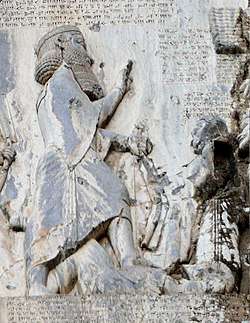
The traditional view is based on several ancient sources, including the Behistun inscription[12] as well as Herodotus,[13] in Ctesias,[14] and Justin, although there are minor differences among them. The three oldest surviving sources agree that Gaumata/Pseudo-Smerdis/Sphendadates was overthrown by Darius and others in a coup d'état, and that Darius then ascended the throne. Most sources (including Darius himself, Herodotus and Ctesias) have Darius as part of a group of seven conspirators. In Greek and Latin sources, Darius subsequently gained kingship by cheating in a contest.
Bardiya was the younger son of Cyrus the Great and a full or half-brother of Cambyses II. According to Ctesias, on his deathbed Cyrus appointed Bardiya as satrap (governor) of some of the far-eastern provinces.[15] According to Darius the Great, Cambyses II, after becoming king of Persia but before setting out for Egypt, killed Bardiya and kept this secret. However, according to Herodotus (who gives two detailed stories), Bardiya went to Egypt with Cambyses and was there for some time but later Cambyses sent him back to Susa out of envy, because “Bardiya alone could draw the bow brought from the Ethiopian king.” Herodotus then states that "Cambyses had a dream in which he saw his brother sitting on the royal throne. As a result of this dream Cambyses sent his trusted counselor Prexaspes from Egypt to Susa with the order to kill Smerdis" (i.e., Bardiya).[16]
Bardiya's death was not known to the people, and so in the spring of 522 BC, a usurper pretended to be him and proclaimed himself king on a mountain near the Persian town of Paishiyauvada. Darius claimed that the real name of the usurper was Gaumata, a Magian priest from Media; this name has been preserved by Justin but given to his brother Cambyses (called Patizeithes by Herodotus), who is said to have been the real promoter of the intrigue. According to Herodotus, the name of the Magian usurper was Oropastes, but according to Ctesias it was Sphendadates.
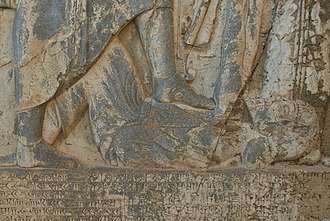
The despotic rule of Cambyses, coupled with his long absence in Egypt, contributed to the fact that "the whole people, Persians, Medes and all the other nations," acknowledged the usurper, especially as he granted a tax relief for three years.[18] Cambyses began to march against him, but died in the spring of 522 BC in disputed circumstances. Before his death he confessed to the murder of his brother, and publicly explained the whole fraud, but this was not generally believed. Nobody had the courage to oppose the new king, who ruled for seven months over the whole empire. The new king transferred the seat of government to Media. A number of Persian nobles discovered that their new ruler was an impostor, and a group of seven nobles formed a plot to kill him. They surprised him at a castle in Nisa, home of the Nisean horses, and stabbed him to death in September 522 BC. One of the seven, Darius, was proclaimed as ruler shortly after.
While the primary sources do not agree on the names and many other details, the three oldest surviving sources (Darius himself, Herodotus and Ctesias) all portray Gaumata/Pseudo-Smerdis/Sphendadates as an imposter who usurped the throne by posing as one of the sons of Cyrus the Great, i.e. as one of the brothers of Cambyses II. In Darius' trilingual Behistun inscription, the prince being impersonated is named "Pirtiya" in Elamite, "Bardiya" in Old Persian, and "Barziya" in Akkadian. In Herodotus' Histories, the prince and his imposter have the same name (Smerdis). For Ctesias, Sphendadates poses as 'Tanyoxarces'. Other Greek sources have various other names for the figure being impersonated, including 'Tanoxares', 'Mergis' and 'Mardos'.[19]:98
In Herodotus' Histories
_(14746859616).jpg)
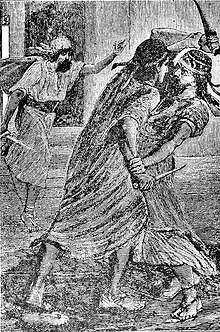
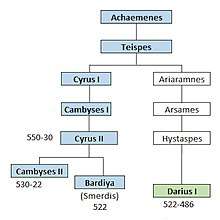
A longer version of the story appears in Book 3 of Herodotus' Histories, written c. 450 BC. That story there (3.1–38, 3.61–88) can be roughly summarized as follows:[20][13]
While in Egypt, Cambyses wounds the thigh of the sacred bull worshipped as the god Apis, and when the sacred bull dies from the wound, Cambyses loses his already tenuous grasp on sanity (3.27–3.30). Jealous of his brother Smerdis' skill with a particular bow brought from the king of Ethiopia, Cambyses sends Smerdis back to Persis. Cambyses then has a dream in which Smerdis would supplant him, so he sends a henchman to murder him secretly (3.30). The assassination succeeds and is meant to be kept secret.
One of the few that know of Smerdis' death is Patizeithes, the steward of Cambyses' palace at Susa. That steward has a brother who greatly resembles Smerdis in appearance, and whose name is also Smerdis (3.61.1). The steward then puts his brother on the throne, and has him pretend that he is the brother of Cambyses. The false Smerdis succeeds in the deception by not allowing anyone who knew the real Smerdis into his presence (3.61).
Still in Egypt, Cambyses learns of the false Smerdis, and knowing that the real Smerdis is dead, recognises the deception. Cambyses then readies his army to return to Susa, but while mounting his horse accidentally injures his thigh with the point of his sword. Cambyses dies from the wound a few days later (3.63–3.66). On his death bed, Cambyses perceives Smerdis as favouring a return to Median hegemony (3.65). The false Smerdis then continues to rule at Susa for some time, and gains support from everyone except the Persians when he grants a three-year military draft and tax exemption to the various peoples of the empire (3.67).
Meanwhile, Otanes, a nobleman of Persis, suspects that the king is not the brother of Cambyses, but rather the Smerdis whose ears Cyrus had commanded be cut off "for some grave reason" (3.69.6). To confirm his suspicion, Otanes asks his daughter Phaidyme – who is a member of the harem and thus has access to the king – to check whether the man has ears. Phaidyme does as asked, and one night while the king is asleep, confirms that the king does not in fact have ears. His suspicions confirmed, Otanes then gathers six noblemen and plots to get rid of the false Smerdis. A seventh nobleman, Darius, arrives at the capital shortly thereafter, and is then included in the group. The seven conspirators charge into the chambers of the king, and while five deal with the guards, Darius and Megabyzus kill the false Smerdis and a companion.
Five days later, after the tumult has died down, the seven meet again to discuss a suitable form of government (3.80–82). After some discussion over the merits of democracy (proposed by Otanes) and oligarchy (proposed by Megabyzus) and monarchy (proposed by Darius), four of the seven vote in favour of a monarchy. They then decide to hold a contest whereby whichever of them got his horse to neigh first after sunrise shall become king. Darius cheats and ascends the throne (3.84–3.87).
In Ctesias' Persika
Ctesias' version (c. 400 BC) runs as follows (XI/F9.8 and XII/F13.11-17, via Photius Bibl. 72):[21][14]
King Cyrus, as he lay dying, appointed his elder son, Cambyses, to the throne and appointed his younger son, Tanyoxarces, governor of the provinces of Bactria, Chorasmia, Parthia, and Carmania. Shortly after Cambyses ascends the throne, a certain Sphendadates who had been whipped by Tanyoxarces for some offence, informs Cambyses that his brother is plotting against him. As proof of this he declares that Tanyoxarces would refuse to come if summoned.
When Tanyoxarces does not immediately accede to the summons, Cambyses begins to believe Sphendadates, who then begins to slander Tanyoxarces more freely. By the time Tanyoxarces finally arrives, Cambyses is determined to put him to death, but hesitates. Sphendadates suggests that, since he (Sphendadates) looks very much like Tanyoxarces, he could take the prince's place. Cambyses agrees, and Tanyoxarces is killed by being forced to drink bull's blood. Sphendadates then takes the place as governor of the eastern provinces.
Five years later, while in Babylon, Cambyses accidentally wounds himself in the thigh, and dies eleven days later. Upon hearing of Cambyses death, Sphendadates (alias Tanyoxarces) returns to the capital and succeeds Cambyses. Meanwhile, Izabates, a confidant of Cambyses who knew of the killing of Tanyoxarces, is on his way with the body of Cambyses. Upon arriving at the capital and finding Sphendadates on the throne, Izabates exposes the fraud. Then, seven noblemen (among them Darius) conspire against Sphendadates. The seven are admitted to the palace by a co-conspirator, where Sphendadates is then killed. The seven then decide to hold a contest whereby whichever of them got his horse to neigh first after sunrise shall become king. Darius gets his horse to be the first to neigh (F13.17: "the result of a cunning stratagem") and he ascends the throne.
Revisionist view
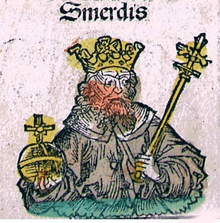
The evaluation of the sources has been cause for much disagreement in modern scholarship. While there is agreement that Darius seized the throne through a coup d'état, some historians consider that the person who ruled for a few months was the real son of Cyrus, and that the story of his impersonation by a magus was an invention of Darius to justify his seizure of the throne.[22][23][24][25]
The key argument against a fabrication is that there is no evidence for it, and lacking further discoveries that view "must remain hypothetical".[26] However the idea that Gaumata was a fabrication is nonetheless appealing because "it was vital for a man like Darius, who had no particular rights to the throne, to invent a character (Gaumāta) condemned for his acts against gods and men."[27] There are some implausibilities in the official story, e.g. the impostor resembled the real Bardiya so closely that most of his wives did not spot the difference, except for queen Phaidyme.[28][29] Darius often accused rebels and opponents of being impostors (such as Nebuchadnezzar III) and it could be straining credulity to say that they all were.[11][25][30]
Aftermath
In the next year, another person claiming to be Bardiya, named Vahyazdāta (Old Persian: 𐎺𐏃𐎹𐏀𐎭𐎠𐎫[31]) rose against Darius in eastern Persia and met with great success, but he was finally defeated, taken prisoner and executed.[32] Perhaps he is identical with the King Maraphis "the Maraphian," name of a Persian tribe, who occurs as successor in the list of Persian kings given by Aeschylus.[33]
The real Bardiya had only one daughter, called Parmys, who eventually married Darius the Great.
Some contracts dating from his reign have been found in Babylonia, where his name is spelt Barziya or Bardiya.[34] Darius says that Bardiya destroyed some temples, which Darius later restored. Bardiya also took away the herds and houses of the people, which Darius corrected once he gained the throne.[35]
The death of the false Bardiya was annually celebrated in Persia by a feast called "the killing of the magian," (Magiophani) at which no magian was allowed to show himself.[36][37]
Bardiya in fiction
This episode is dealt with by Gore Vidal in his novel Creation. He takes the view that the person who ruled for a few months was the real Bardiya.
"The impostor magician Smerdis" is mentioned in the short story by Jorge Luis Borges, Tlön, Uqbar, Orbis Tertius. He is the only historical character that the protagonist is able to recognize when discovering the article on the fictitious nation of Uqbar, and it is stated that his name has been invoked mainly as a metaphor.
References
- Akbarzadeh, D.; A. Yahyanezhad (2006). The Behistun Inscriptions (Old Persian Texts) (in Persian). Khaneye-Farhikhtagan-e Honarhaye Sonati. p. 59. ISBN 964-8499-05-5.
- Kent, Roland G. (1950). Old Persian: Grammar, Texts, Lexicon.
- "Bardiya | king of Persia". Encyclopedia Britannica. Retrieved 2020-08-14.
- Akbarzadeh, D.; A. Yahyanezhad (2006). The Behistun Inscriptions (Old Persian Texts) (in Persian). Khaneye-Farhikhtagan-e Honarhaye Sonati. p. 60. ISBN 964-8499-05-5.
- Kent, Roland G. (1950). Old Persian: Grammar, Texts, Lexicon.
- Ctesias Pers. 8
- Xenophon Cyrop. Vin. 7.ii
- Justin i.9, Mergis
- Aeschylus Pers. 774
- Leick, Gwendolyn Who's Who in the Ancient Near East
- Van de Mieroop, Marc A History of the Ancient Near East, ca. 3000–323 B.C. 2nd edition (Oxford 2007) pp. 290–291
- livius.org/articles/place/behistun
- A. D. Godley Herodotus : The Persian Wars : Books 3–4 (Cambridge, MA 1921) pp. 38–41, 76–117 Commons:File:Smerdis(Herodotus).pdf
- Ctesias; Stronk, Jan P., tr. (2010), Ctesias' Persian History: Introduction, text, and translation, Wellem, pp. 323–325.
- Ctesias, Persica: Book 11, Fragment 9, taken from Photius' excerpt https://www.livius.org/ct-cz/ctesias/photius_persica.html#%A78 cf. Xenophon Cyrop. vin. 7, if
- Dandamaev, M. (2001). "Bardia". Encyclopaedia Iranica. 3. New York.
- Behistun, minor inscriptions DBb inscription- Livius.
- Herodotus III.68
- Briant, Pierre (2002), From Cyrus to Alexander: A History of the Persian Empire, Eisenbrauns.
- Herodotus; Godley, A. D., tr. (1931), Herodotus, with an English translation by A. D. Godley, London: Heinemann.
- Ctesias; Nicols, Andrew, ed., tr. (2008), The Complete Fragments of Ctesias of Cnidus, University of Florida (PhD thesis), pp. 25, 90, 92–93.
- Olmstead, A. T. (1959), History of the Persian Empire, University of Chicago Press.
- Axworthy, Michael (2008), Iran: Empire of the Mind, New York: Basic Books.
- Van De Mieroop, Marc (2006), A History of the Ancient Near East (2nd ed.), Blackwell.
- Holland, Tom Persian Fire
- Dandamayev, M. A. (1988), "Bardiya", Encyclopedia Iranica, vol. 3, fasc. 8, Costa Mesa: Mazda, pp. 785–786.
- Briant, Pierre (2000), "Gaumāta", Encyclopedia Iranica, vol. X, fasc. 3, New York: Routledge, Kegan Paul, pp. 333–335.
- http://www.persepolis.nu/queens.htm#phaidyme
- Bourke, Dr. Stephen (chief consultant) The Middle East: Cradle of Civilisation Revealed p. 225, ISBN 978-0-500-25147-8
- Behistun Inscription 4.1 (52)
- Akbarzadeh, D.; A. Yahyanezhad (2006). The Behistun Inscriptions (Old Persian Texts) (in Persian). Khaneye-Farhikhtagan-e Honarhaye Sonati. p. 115. ISBN 964-8499-05-5.
- Behistun Inscription ~ 40 if.
- Aeschylus Pers. 778
- For the chronology, see Parker & Dubberstein, Babylonian Chronology.
- Behistun Inscription i.14
- Herodotus III.79
- Ctesias Pers. 15

Bardiya Born: ?? Died: 522 BC | ||
| Preceded by Cambyses II |
King of Kings of Persian Empire 522 BC |
Succeeded by Darius the Great |
| Pharaoh of Egypt 522 BC | ||
| Wikimedia Commons has media related to Smerdis. |
